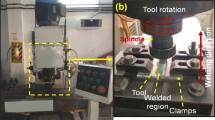Abstract
This study aimed to investigate the design S-N curve on the basis of the hot spot stress (HSS) approach considering proper thickness effect for welded aluminum joints. The effect of the main plate thickness is examined by using the results of fatigue tests in this study and references of fatigue data of previous literature. The fatigue tests are performed on 5083-O welded joint specimens with four kinds of main plate thicknesses, namely 12 mm, 16 mm, 20 mm, and 25 mm. The main plate thicknesses of the fatigue data of the references ranged from 2.8 to 25 mm. We clarify the relationship between fatigue strength and main plate thickness, and propose hot spot design S-N curve for welded aluminum joints with thickness of less than 25 mm based on the research of the thickness effect. Fatigue tests of large-scale model are carried out to test the validity of the proposed design S-N curve for welded structures.

























Similar content being viewed by others
References
European committee for standardization (2007) BS EN 1999-1-3: 2007 Eurocode 9: design of aluminium structures–Part 1–3: structures susceptible to fatigue
IIW (2016) Recommendations for fatigue design of welded joints and components. IIW document IIW-2259-15
ABS (2017) Guide for building and classing for liquefied gas carriers with independent tanks
Gurney TR (1977) Theoretical analysis of the influence of toe defects on the fatigue strength of fillet welded joints. Welding Institute, Cambridge
Ribeiro AS, de Jesus AM, Feup I (2011) In: Kvackaj T (ed) Fatigue behaviour of welded joints made of 6061-T651 aluminium alloy. Aluminium Alloys, Theory and Applications, pp 135–156
Bloem C, Salvador M, Amigó V, Vergara M (2011) Aluminium 7020 alloy and its welding fatigue behaviour. Aluminium alloys, theory and applications. Rijeka, Croatia: InTech, 115–134
Coughlin R, Walbridge S (2012) Fatigue testing and analysis of aluminum welds under in-service highway bridge loading conditions. J Bridg Eng 17(3):409–419
Partanen T, Niemi E (1999) Hot spot S-N curves based on fatigue tests of small MIG-welded aluminum specimens. Weld World 43(1):16–22
Tveiten B W, Xiaozhi W, Berge S (2007) Fatigue assessment of aluminum ship details by hot-spot stress approach. ABS Technical Papers : 255-271
Zamzami IA, Susmel L (2017) On the accuracy of nominal, structural, and local stress based approaches in designing aluminium welded joints against fatigue. Int J Fatigue 101:137–158
Maddox S J (1995) Scale effect in fatigue of fillet welded aluminum alloys. 6th Int Conf on Al. Weldments
Shiratsuchi T, Osawa N (2020) Investigation of thickness and bead profile effects on fatigue strength of welded joints based on relative stress gradient. Int J Fatigue 134:105520
Japanese Industrial Standards Committee (2014) JIS H 4000. Aluminium and aluminium alloy sheets, strips and plates
Japanese Industrial Standards Committee (2009) JIS Z 3232. Aluminium and aluminium alloy welding rods and wires
Lihavainen V M (1996) Result of fatigue strength of MIG-welded aluminium extrusions. Fatigue Design 1996, Technical Research Centre of Finland
Hakuli K (1996) Hot spot fatigue tests of fillet welds of AlMgSi1 (6082-T6) aluminium. Fatigue Design 1996, Technical Research Centre of Finland
Japan Ship Technology Research Association (1991) Study on fatigue design method and quality of welding for offshore structures (in Japanese)
Davidson CJ, Griffiths JR, Machin AS (2002) The effect of solution heat-treatment time on the fatigue properties of an Al-Si-Mg casting alloy. Fatigue Fract Eng Mater Struct 25(2):223–230
Yamada K, Makino T, Kikuchi Y (1979) Fracture mechanics analysis of fatigue cracks emanating from toe of fillet weld. Proc Japan Soc Civ Eng 292:1–12
Yamada K, Albrecht P (1977) Practical aspects of fatigue analysis of a weldment. Fracture 1977, Vol. 2. In Proc. of Fourth Int Con Fracture, 959–966
Abtahi A, Albrecht P, Irwin GR (1976) Fatigue of periodically overloaded stiffener detail. Proc. of ASCE 102(ST11):2103–2119
Mann D (1977) LNG materials and fluids. National Bureau of Standards, Boulder, Colo. 80302. 1977, Sections paged separately (Book)
Warzynek PA, Carter BJ, Banks-Sills L (2005) The M-integral for computing stress intensity factors in generally anisotropic materials. NASA/CR-2005-214006
Rice JR (1968) A path independent integral and the approximate analysis of strain concentration by notches and cracks. J Appl Mech 35:379–386
ASTM international (2008) ASTM E647-08, standard test method for measurement of fatigue crack growth rates
Hirukawa H, Matsuoka S, Takeuchi E, Nishijima S (1996) Fatigue properties of JIS aluminum alloys for welded structures. Trans Japan Soc Mech Eng (A) 62:601 1966-1971
Takenouchi K (1999) Fatigue strength design of welded aluminum structures, Japan light metal welding association (in Japanese)
Atzori B, Indrio P (1976) Comportamento a fatica dei ciunti saldati in Al Zn Mg1, Al Zn4 Mg1 ED Al Mg Si. University of Bari, Italy, Report No. 76/5
Jacoby G (1961) Uber das Verhalten von Schweissverbindungen aus Alumininumlegierungen bei Schwingbeansprunchung. Dissertation, Technische Hochschule, Hannover
Sidhom N, Laamouri A, Fathallah R, Braham C, Lieurade HP (2005) Fatigue strength improvement of 5083 H11 Al-alloy T-welded joints by shot peening: experimental characterization and predictive approach. Int J Fatigue 27(7):729–745
Author information
Authors and Affiliations
Corresponding author
Additional information
Publisher’s note
Springer Nature remains neutral with regard to jurisdictional claims in published maps and institutional affiliations.
Recommended for publication by Commission XIII - Fatigue of Welded Components and Structures
Rights and permissions
About this article
Cite this article
Shiratsuchi, T., Izumi, N., Imai, T. et al. The thickness effect of hot spot S-N curves for welded aluminum joints. Weld World 64, 1521–1534 (2020). https://doi.org/10.1007/s40194-020-00936-w
Received:
Accepted:
Published:
Issue Date:
DOI: https://doi.org/10.1007/s40194-020-00936-w




